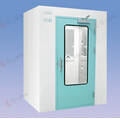The uniqueness of cosmetics and other products lies in their direct use on people's faces. Once they come into contact with pollutants during the production process, they can easily cause skin allergies and, more seriously, skin ulcers. Some cosmetics, such as lipstick and lipstick, are more likely to enter the mouth of users directly. If we do not pay attention to the production environment of cosmetics, it will not only affect the product qualification rate, but also cause certain harm to people's health. A clean room can effectively prevent cosmetics from coming into contact with unclean air during the production process and prevent the generation of pollutants.
Some cosmetics also have certain requirements for temperature and humidity. Some creamy cosmetics are prone to denaturation in an overheated environment, while they can solidify in an excessively cold environment, affecting the final product. Humidity is also a very important indicator. Cosmetics generally require a relatively dry environment, firstly to ensure product quality, and secondly to prevent the growth of microorganisms. Clean rooms not only ensure air quality, but also flexibly control temperature and humidity to create the most suitable production environment for products.
In short, the clean room plays a very important role in the production of cosmetics, as it can ensure the quality and safety of cosmetics, while also improving production efficiency and reducing costs. In the future, with the continuous progress of technology and the increasing demand of consumers for the safety and quality of cosmetics, clean rooms will continue to be upgraded and improved. For example, some companies are now using more advanced cleanroom technologies, such as nanotechnology and high-voltage electrostatic technology, to control the number of particles and microorganisms in the cleanroom, thereby further improving the quality and safety of cosmetics.


